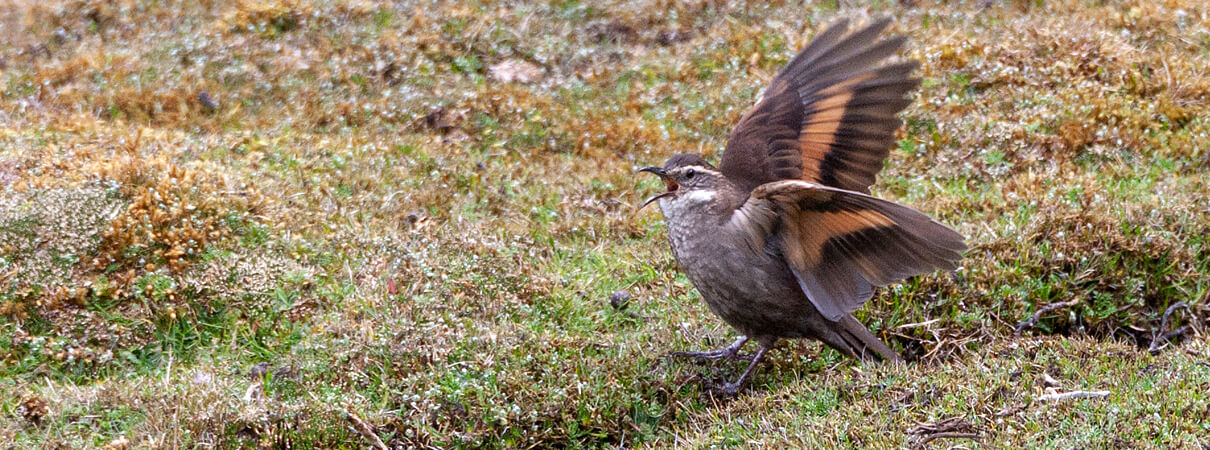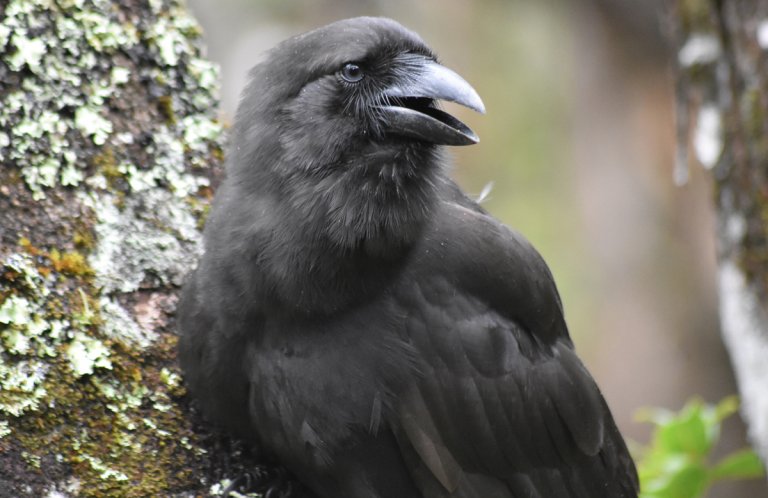 The stocky, dark-brown Royal Cinclodes can only be found in woodlands high in the Andes of Peru and Bolivia, almost exclusively in those dominated by trees in the genus Polylepis and, reported just recently, Gynoxis. The word cinclodes derives from the Greek words for "resembling" and "unknown waterside bird," reflecting the family's frequent occurrence in areas near streams and shorelines.
The stocky, dark-brown Royal Cinclodes can only be found in woodlands high in the Andes of Peru and Bolivia, almost exclusively in those dominated by trees in the genus Polylepis and, reported just recently, Gynoxis. The word cinclodes derives from the Greek words for "resembling" and "unknown waterside bird," reflecting the family's frequent occurrence in areas near streams and shorelines.
The Royal Cinclodes is part of the diverse family Furnariidae, or ovenbirds, which are found only in South and Central America, and southern Mexico. This large group contains more than 230 bird species in nearly 60 genera, including other endangered species such as the Pinto's Spinetail.
Family Ties
Members of the family Furnariidae, also called furnariids, are nicknamed "ovenbirds" because of the nesting habits of several well-known family members, including the Rufous Hornero, which builds a conspicuous dome-shaped mud nest. The Royal Cinclodes and some other furnariids nest in tunnels dug into banks or underground, while other species build large, elaborate stick nests. The migratory Ovenbird of North America also builds a dome-shaped nest, but is a warbler, not a furnariid.
Although diverse in size, bill shape, and habitats, furnariids are united by a number of common features: the muscles of the syrinx (voice box); muted brown plumage, often with conspicuous patterning; and strong legs and feet. This family is one of the few that thrives in the cold, inhospitable heights of the Andes, down through the southern end of the continent.
Most ovenbirds vocalize persistently and loudly, but their songs tend to be simple, harsh trills and buzzes. The Royal Cinclodes' loud, trilling song is typical of this family.
(Audio of Royal Cinclodes by Joseph Tobias & Nathalie Seddon XC73370, accessible at www.xeno-canto.org/73370)
Remarkable Trees for a Rare Species
There are more than 20 species of shrubs and trees in the genus Polylepis, all found in the Andean mountains from northern Venezuela south to northern Chile and Argentina. Members of the rose family, these evergreen trees with reddish, peeling bark are the highest-growing flowering trees in the world, occurring at elevations up to 16,400 feet. They also grow very slowly, with some taking more than a century to reach a half-inch in diameter.
Undisturbed Polylepis forests are remarkably lush, with many lichens and thick layers of moss growing on the tree trunks and forest floor. However, across much of their range, Polylepis forests have been severely threatened by years of firewood harvesting. Livestock grazing and fires also inhibit the natural regeneration of these slow-growing forests and their mossy understories.
A Royal Diet
The Royal Cinclodes forages through the Polylepis forest understory, using its strong, downward-curved bill to probe mosses, leaf litter, and decaying wood in search of beetles, larvae, small vertebrates such as frogs, and seeds. In its quest for food, it also pulls up moss and flakes bark off the base of Polylepis trees.
Like other ovenbirds, the Royal Cinclodes often uses a foot to hold down prey against a branch or the ground as it feeds, a behavior shared by only a few other songbirds, including the Loggerhead Shrike.

Royal Cinclodes by Agami Photo Agency, Shutterstock
Tunnel-Nester
Like many other cinclodes species, the Royal Cinclodes builds its simple cup nest at the end of a tunnel dug into a bank or cliff face, a well-protected nest site in this bird's cold and windy habitat. Many other birds seek the protection of tunnels for nesting, including the Belted Kingfisher and pelagic species such as the Pink-footed Shearwater and Hawaiian Petrel. The Royal Cinclodes will also use natural crevices and rodent burrows as nest sites.
Frequently seen in pairs throughout the year, Royal Cinclodes are thought to be monogamous, perhaps even forming lifelong pair-bonds.
Long-Running Conservation
ABC has long worked with local partners and communities to protect the Royal Cinclodes and Polylepis forests in both Peru and Bolivia.
In Bolivia, ABC has worked with partners Asociación Armonía and Insituto de Ecología to plant thousands of trees and provide improved wood-burning stoves to reduce communities' dependence on Polylepis wood for fuel.
In Peru, ABC and partner Asociación Ecosistemas Andinos (ECOAN) have worked with communities in the Vilcanota Mountains near Cuzco to restore and protect Polylepis forests, which support a large portion of the total Royal Cinclodes population, as well as other threatened species such as the Ash-breasted Tit-Tyrant and White-browed Tit-Spinetail. These forests also benefit local people by providing erosion control and protecting water sources.
ABC has assisted ECOAN with this project for nearly 20 years, resulting in the creation of eight community-based private conservation areas spanning more than 18,000 acres. This reserve network includes more than 1.4 million trees planted for habitat restoration and for fuelwood plantations to benefit the Royal Cinclodes and other birds — the highest number of trees planted at any single ABC-supported project.



















































